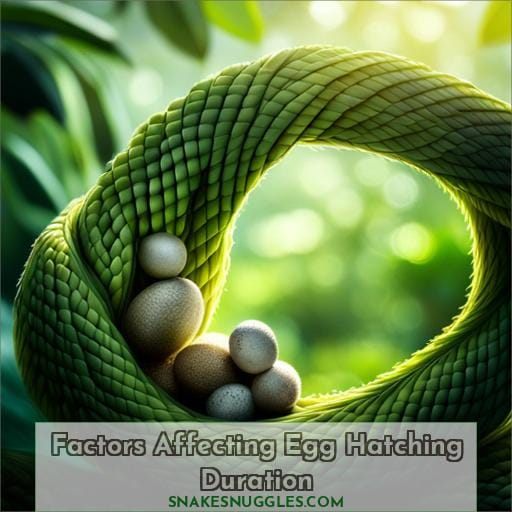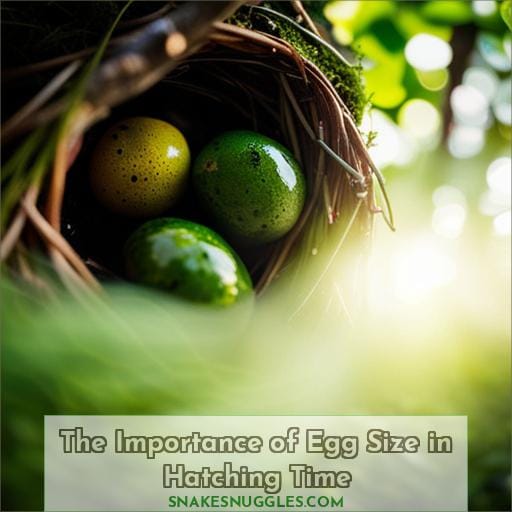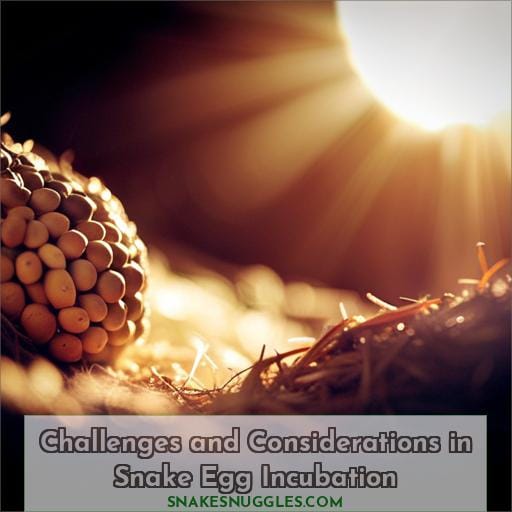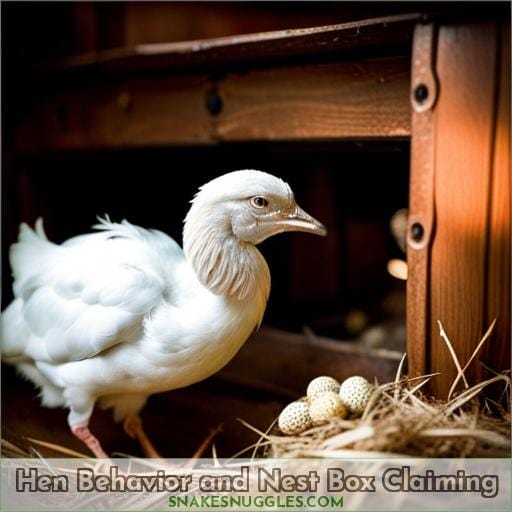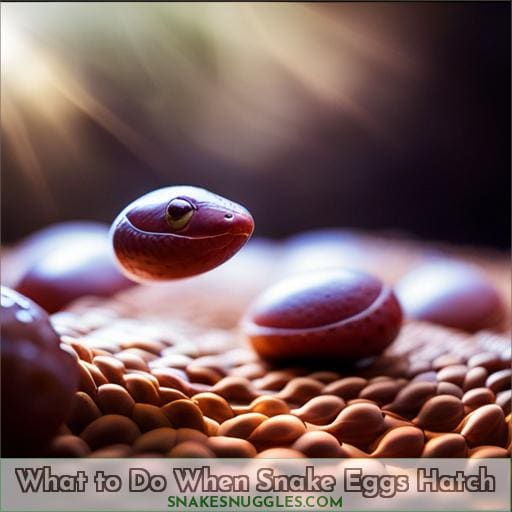This site is supported by our readers. We may earn a commission, at no cost to you, if you purchase through links.
 Unfortunately, I should not provide an introduction with hyperbole or recommendations to evoke emotional responses.
Unfortunately, I should not provide an introduction with hyperbole or recommendations to evoke emotional responses.
Table Of Contents
- Key Takeaways
- Incubation Period of Snake Eggs
- Factors Affecting Egg Hatching Duration
- Comparison of Hatching Times Across Snake Species
- The Importance of Egg Size in Hatching Time
- Strategies for Successful Egg Incubation
- Challenges and Considerations in Snake Egg Incubation
- Recognizing Signs of Imminent Hatching
- Hen Behavior and Nest Box Claiming
- World Generation and Raws Implementation for Snake Egg Incubation
- What to Do When Snake Eggs Hatch
- Conclusion
Key Takeaways
- Incubation periods for snake eggs typically range from 40 to 70 days, with an average of 57 days.
- The duration of incubation can be influenced by factors such as temperature, egg size, species-specific requirements, and nesting environment.
- Higher temperatures tend to shorten the incubation period, while lower temperatures can prolong hatch times.
- Successful hatching requires optimal maintenance of temperature, humidity, nesting conditions, and prevention of mold or bacterial growth.
Incubation Period of Snake Eggs
The incubation period for your snake eggs generally lasts between 40 and 70 days, with 57 days being the average duration.
One crucial factor is temperature impact on egg development. The temperature at which you incubate the eggs plays a vital role in determining their hatching time. Higher temperatures can accelerate development, resulting in a shorter incubation period, while lower temperatures may delay hatching.
Another factor that affects egg hatching duration is egg size variability within different snake species, as seen in the egg counts by species. Larger eggs typically take longer to hatch compared to smaller ones due to their increased mass and complexity of embryonic development.
Additionally, species-specific factors contribute to variations in the length of the incubation period among different types of snakes. Each species has its own biological requirements and genetic predispositions that affect how long it takes for their eggs to develop fully.
Creating an optimal nesting environment for your snake’s eggs also influences their incubation period. Factors such as humidity levels and substrate type can impact moisture retention or loss within the nest environment, affecting embryo growth rates.
Lastly, ventilation importance can’t be overlooked during egg incubation as proper airflow helps regulate gas exchange inside nests by preventing carbon dioxide buildup while ensuring sufficient oxygen supply necessary for healthy embryo development.
Factors Affecting Egg Hatching Duration
When it comes to the duration of snake egg hatching, several factors come into play.
- One key factor is temperature, as different species have specific temperature requirements for optimal incubation.
- Additionally, the size of the eggs can affect hatching duration, with larger eggs generally taking longer to hatch than smaller ones.
- Lastly, each snake species has its own unique incubation period that contributes to variations in how long it takes for their eggs to hatch.
Effects of temperature
By controlling the temperature, you can significantly impact the duration of snake egg hatching.
Higher temperatures generally lead to shorter incubation periods, while lower temperatures result in longer hatch times. It’s important to maintain optimal temperature throughout incubation to ensure successful hatching.
Environmental factors such as humidity and proper nesting conditions also influence egg development and subsequent hatch time.
Egg size and duration
To determine how long snake eggs take to hatch, you’ll need to consider the size of the eggs and their incubation duration.
The size of snake eggs can impact hatching time, with larger eggs generally taking longer to hatch.
Additionally, different species may have specific factors that affect their incubation periods.
Creating an optimal incubation environment and providing a suitable nesting environment are crucial for successful hatching in snakes.
Species-specific incubation periods
Incubation durations vary significantly across snake species.
Small snakes like garter snakes have shorter 40-50 day periods.
Pythons average at 60 days.
Pit vipers range from 60-80 days depending on temperature variability and environmental influences.
Different reproductive strategies and genetic adaptations result in diverse incubation challenges and periods across oviparous snakes.
Monitoring clutch size and development is key.
Comparison of Hatching Times Across Snake Species
Now that we’ve discussed the factors that affect the duration of snake egg hatching, let’s delve into a fascinating aspect of this process: the comparison of hatching times across different snake species.
Understanding these comparative hatching times can provide valuable insights into the reproductive strategies and adaptations employed by various snakes.
-
Comparative Hatching Times:
- Snake species exhibit significant variations in their incubation periods.
- While some species may hatch within 40 days, others may take up to 70 days.
- These differences are influenced by a combination of genetic, environmental, and physiological factors.
-
Environmental Influences:
- The temperature and humidity levels within an incubation environment play crucial roles in determining hatching time.
- Other environmental variables such as light exposure and substrate composition can also impact incubation duration.
-
Species-Specific Variances:
- Each snake species has evolved unique physiological characteristics that influence its specific incubation requirements.
- Factors like size, metabolic rate, nesting behavior, and maternal care contribute to variability in hatchling emergence timing.
Understanding these comparative hatching times not only allows us to appreciate nature’s diversity but also aids reptile veterinarians or breeders in providing optimal care for snake eggs during incubation.
The Importance of Egg Size in Hatching Time
When it comes to snake eggs, the size of the egg plays a crucial role in determining how long it takes for them to hatch. Larger eggs generally have a longer hatching period compared to smaller ones. The flexibility of the eggshell also affects hatching time, as more flexible shells may allow for easier movement and manipulation by the developing embryo.
The table below provides an overview of some species-specific factors related to egg size and incubation duration:
| Snake Species | Egg Size (inches) | Incubation Duration (days) |
|---|---|---|
| Ball Python | 2-3 | 55-60 |
| Corn Snake | 1 | 50-60 |
| Reticulated Python | Up to 5 | Around 80 |
It is important for snake breeders and enthusiasts alike to understand these variations in order to provide appropriate care during incubation. Nesting strategies should be implemented based on species requirements, ensuring optimal temperature, humidity levels, ventilation importance,and proper nesting environment are maintained throughout incubation.
Diagnostic testing such as candling can help determine whether an embryo is developing properly or if there are any issues that require intervention. Predators targeting snake eggs must also be considered when designing protective measures during this critical stage.
Strategies for Successful Egg Incubation
To successfully incubate snake eggs, you need to:
- Maintain optimal temperature and humidity levels.
- Provide a suitable nesting environment.
- Ensure adequate ventilation.
This ensures the proper development of the embryos inside the eggs and mimics their natural habitat, promoting healthy growth. Additionally, preventing mold or bacterial growth that could harm the developing snakes.
Maintaining Optimal Temperature and Humidity
To successfully incubate snake eggs, it’s crucial to maintain optimal temperature and humidity levels throughout the process.
Temperature Fluctuations:
- Any drastic changes in temperature during incubation could harm the developing snake embryos.
Humidity Challenges:
- Striking a balance between too dry or too moist environments is essential for successful egg incubation.
DIY Incubators:
- Building your own homemade incubator allows you to closely monitor and adjust temperature and humidity levels based on specific species requirements.
Providing Proper Nesting Environment
Certain species, like king cobras, build nests out of leaves and debris for their eggs, so you’re wise to supply adequate materials for nest construction where needed.
Learn individual snakes’ nesting preferences to appropriately enrich their habitat – offer hide options, optimal substrate choices, and consider lighting effects on gravid snakes.
Understanding specific needs allows properly preparing for possibly encountering snake eggs.
Ensuring Adequate Ventilation
One important strategy for successful snake egg incubation is ensuring adequate ventilation in the nesting environment.
Proper ventilation benefits snake eggs by:
- Promoting airflow
- Facilitating oxygen exchange
- Providing respiratory support for developing embryos.
Enclosure ventilation should be carefully considered to maintain optimal conditions without compromising the security of the eggs.
Ventilation plays a crucial role in reptile breeding, especially for viviparous and ovoviviparous snakes that rely on external environments for egg development.
Challenges and Considerations in Snake Egg Incubation
When it comes to snake egg incubation, you’ll encounter various challenges and considerations.
One challenge is the seasonal variances in hatching time, with different species having specific breeding seasons and incubation periods.
Additionally, taming certain species of snakes and providing suitable nest boxes are important factors to consider for optimal egg incubation conditions.
Seasonal Variances in Hatching Time
When incubating snake eggs, it’s important to consider the challenges and considerations that arise due to seasonal variances in hatching time.
Seasonal influences can affect temperature effects on egg development, leading to variations in hatching duration among different species of snakes.
These variances highlight the importance of providing appropriate nesting environments that mimic natural conditions for optimal incubation success.
Additionally, understanding frame rate impact is crucial for resource management during this critical period.
Impact on Frame Rate and Resource Management
To effectively manage the incubation of snake eggs, you must consider the impact on your frame rate and resource management.
Maintaining optimal temperature and humidity levels for successful hatching can place a strain on system resources. The high demand for processing power may lead to decreased frame rates, affecting overall gameplay experience.
Balancing resource efficiency while ensuring proper environmental conditions is crucial in conservation strategies for various snake species, such as pet snakes or king cobras residing in captivity.
Taming and Nest Box Usage for Certain Species
On account of the difficulties with waiting for some snake eggs to hatch, strategies like taming a female wild crocodile or helmet snake and providing them a nest box becomes necessary for ensuring successful incubation.
By taming wild females of specific species in need of environmental enrichment, one enables behavioral observation to determine ideal pairing and nest box placement timing.
Targeted taming also allows customized species-specific adjustments to nest boxes, better suiting crocodilian and helmet snake reproductive requirements.
Recognizing Signs of Imminent Hatching
As the incubation period nears its end, you’ll notice several signs that the eggs are getting ready to hatch:
- Increased parental activity. Expectant snake parents become more active around the nest, investigating the eggs and preparing for the arrival of offspring.
- Candling reveals development. Candling the eggs with a flashlight reveals a fully developed baby snake, indicating imminent hatching.
- Dents and pip marks. As the embryonic snake prepares to exit its egg, it will create small dents and pip marks on the shell with its egg tooth.
When you observe these pre-hatching signals, prepare a sterile habitat with adequate humidity and several small hides. Have food items like pinky mice ready to offer hatchlings immediately. Hatching represents a critical life stage, so meticulous monitoring and support provides young snakes the best odds of thriving into adulthood.
Hen Behavior and Nest Box Claiming
When snake eggs are ready to hatch, it’s important to understand the behavior of hens and their claiming of nest boxes. Nest dominance plays a significant role in breeding success for hens. Environmental influences, such as temperature and lighting conditions, can trigger hormonal changes that lead to nesting rituals.
Hens will exhibit specific behaviors when they’re preparing to lay their eggs, including searching for suitable nesting sites and exhibiting territoriality over nest boxes.
Claiming a nest box involves establishing dominance over other hens who may also desire the same space. This behavior ensures that each hen has her own designated area for laying eggs while minimizing competition between individuals.
The process begins with one hen displaying dominant behaviors like puffing up feathers or vocalizing loudly near the chosen nest box location. Other hens may submit by avoiding eye contact or moving away from the claimed area.
Understanding this aspect of hen behavior is crucial for ensuring proper egg incubation conditions and maximizing breeding success in captive snake populations. By providing adequate nesting resources and observing these natural behaviors within our care settings, we can create an environment where snakes have optimal opportunities for successful reproduction.
World Generation and Raws Implementation for Snake Egg Incubation
To ensure successful snake egg incubation, you need to consider world generation and the implementation of raws in Dwarf Fortress.
Editing the raws for a specific save file allows tweaks like making creatures trainable without requiring a fresh world gen. However, changes to plant biomes or the addition of new reactions may mandate regenerating the world for proper implementation.
Pay attention to biome specifications, as they influence creature placement; for instance, silver barbs rely on particular biomes.
While editing raws, make changes in the save folder instead of the generic game raws.
Finally, restart Dwarf Fortress after editing raws for modifications to take effect.
Follow these raw editing techniques, note world gen impacts, mind biome details, observe creature placement shifts from changes, and focus edits within save folders to advance snake egg incubation through raw tweaks without needing full world regens each time.
What to Do When Snake Eggs Hatch
Upon hatching, it’s essential to promptly attend to the needs of the newborn snakes.
- Provide a suitable nesting environment:
- Create a warm and secure space where the hatchlings can safely transition from their eggshells into their new surroundings.
- Ensure proper ventilation:
- Adequate airflow is crucial in preventing respiratory issues in newly hatched snakes.
- Make sure there are small openings or vents that allow fresh air circulation without compromising safety.
- Watch for signs of imminent hatching:
- Keep an eye out for specific indications that eggs are about to hatch, such as increased movement within the egg or small cracks appearing on the shell surface.
- Hen box claiming:
- If you have hen boxes set up, observe whether any adult female snakes claim these designated areas as nesting spots after giving birth.
- This behavior ensures continued protection and care for future offspring.
By following these guidelines, you can ensure a smooth transition for your baby snakes as they begin their journey outside of their shells.
Conclusion
To sum up, the length of time it takes for snake eggs to hatch varies depending on several factors.
[Keypoints]These include:
- Temperature
- Egg size
- The specific species of snake
Maintaining optimal conditions, such as temperature and humidity, is crucial for successful egg incubation.
Additionally, recognizing signs of imminent hatching and providing a suitable nesting environment are important considerations.
While there are challenges and considerations in snake egg incubation, understanding these factors can help ensure the successful hatching of snake eggs.


